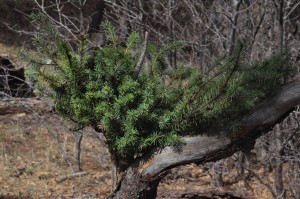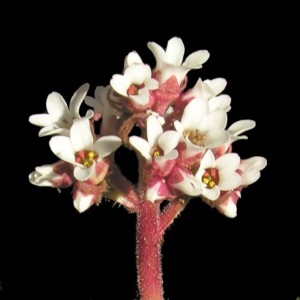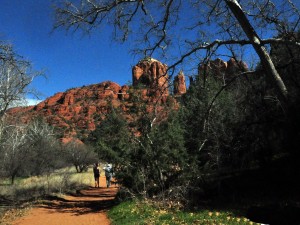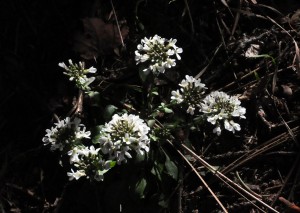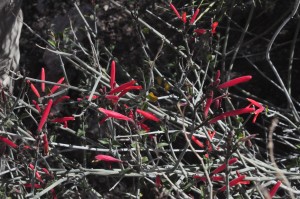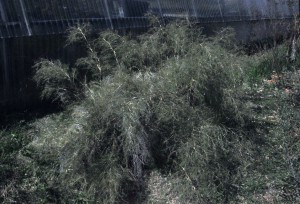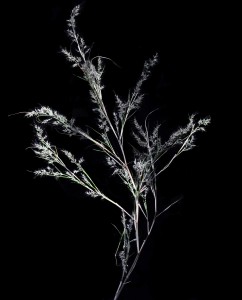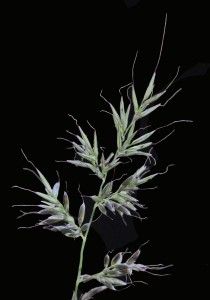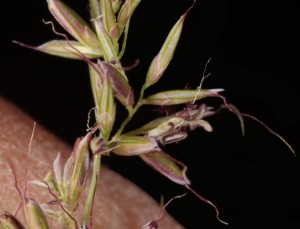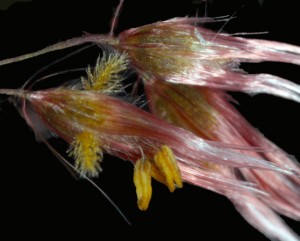On recent plant walks I have found a number of interesting items. On the 26th of February Ed and I were in Catalina State Park and came across a Prickly Pear, growing out of the trunk of a Mesquite tree. I have seen Prickly Pear growing eight feet high on a Saguaro but this was the first time to see one on a Mesquite.
On March the sixth, I drove alone up the Catalina mountains to the Butterfly trail head. It was surprisingly mild considering I was at about 8000′. I was looking for grasses in bloom, and found some, but was not able to identify them yet. On the way I almost tripped over a “witch’s broom.” This is a condition in which the growth pattern of a tree changes so that the branches and needles are much more thickly concentrated forming a kind of basket shape. I took two pictures – one on the ground, and the other propped on a tree stump. Reading about it I learned that trees have growth hormones. Some control the way the plant sends out new branches and some inhibit growth. When the hormones get mixed up the tree forms these very irregular masses of branches, twigs and needles that are considerably heavier than normal growth. In this picture you can see a central branch – so small as to be a twig really, that was supporting this mass. Evidently it broke, and the “basket” came tumbling down. I believe it came off of a Douglas fir.
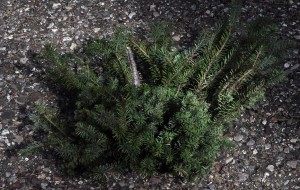
Proceeding along the trail I looked for one of my favorite flowers, the Redfuzz saxifrage. There were still patches of snow on the ground. I learned before that the plant will actually melt enough snow to poke through snow. On this walk I found a few plants with their red buds. By now the buds have opened to reveal these delightful white flowers, harbingers of spring in the mountains.
Redfuzz saxifrage (Micranthes eriophora)
Picture taken a few years ago.
Kayla decided to spend her spring break with her grandparents in Tucson, getting away from one of the harshest winters on record in deKalb, Illinois where she is completing her last year of college at Northern Illinois University. She loved the warmth and sunshine, and hiked with us in Molino Basin. On part of her visit the three of us, my wife, Louise, Kayla and I went for a trip to Sedona. On arrival at the visitors center we were told about a trail to the iconic Red Rock Crossing that we had never been on before. We thoroughly enjoyed the walk. At our farthest point we stood at the edge of the fast-flowing Oak Creek. Later we visited the fascinating shops in Tlaquepaque and then drove up Airport Hill to catch the sunset. Hundreds of other people had the same idea. There was something really nice about seeing so many people gathered, hugging each other in the chill evening air, just to watch the sunset.
Before leaving Sedona the next day we hiked in the West Fork trail. On getting home I was inspired to write this little poem about our final walk.
A POEM OF GRATITUDE
by Frank S Rose, March 12, 2014
The sky overhead is striped with long curving lines of ice crystals
The ground underfoot is red and soft
A cluster of acorn woodpeckers plays tag darting back and forth between the bare apple trees
The air is soft and cool as groups of people make their way up the canyon.
The cliffs of red and ocher block out the morning sun
Up ahead it highlights an enormous Ponderosa pine and lays a patch of gold at its foot
We cross and re-cross the stream tracking damp footprints up the banks of red earth
It is early spring – the bare branches of red osier dogwood give a warm glow to the forest, especially where sunlight touches them
White Candytuft start to appear as we make our way up the canyon first a few – then a cluster, then a celebration.
There are a few yellow mustard plants just showing their colors
We see a thicket of ancient horsetail the great survivors of earlier times
Happy people greet us, including the couple that spoke to us as we waited to get seated at the restaurant last night.
Lively teens and wobbling infants add to the pageant of human life visiting this treasured part of Oak Creek.
We turn around just before stream crossing number 5 (out of 13) and soon are treated to new flowers
The pink Valerian we missed on the way up the canyon, now reminding us how easy it is to overlook nature’s treasures
We complete our timeless interlude to begin the long drive home.
Kayla and Louise walking toward Red Rock Crossing
People gathered to watch the sunset in Sedona
Wild Candytuft (Noccaea fendleri)


